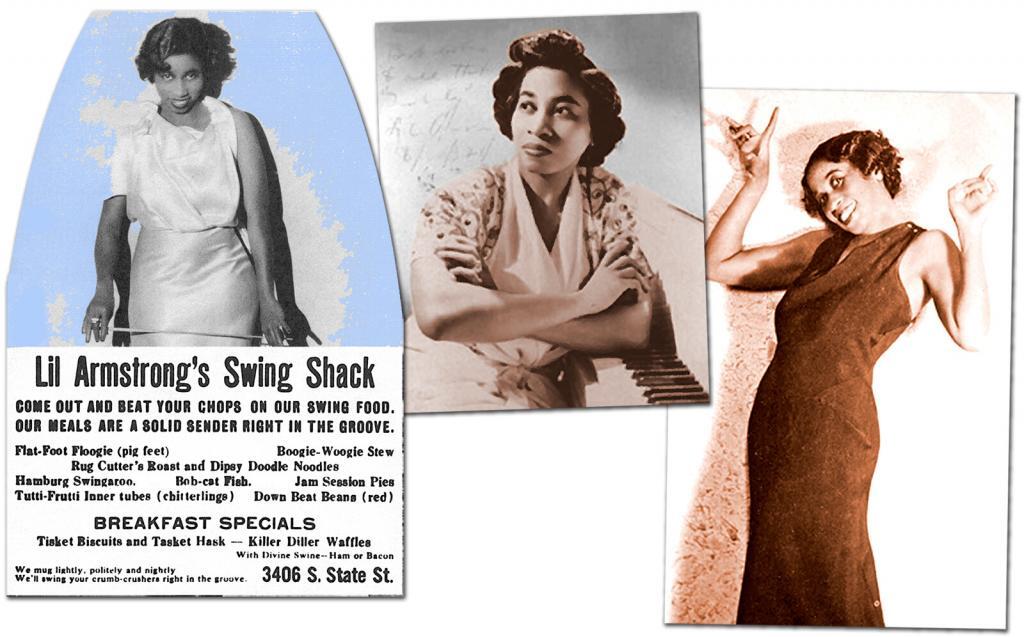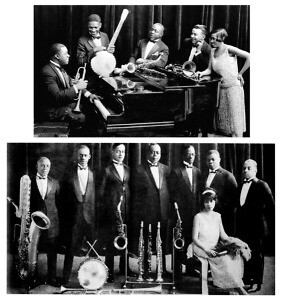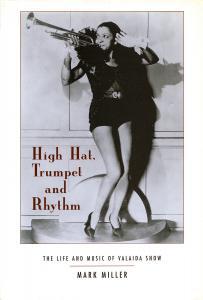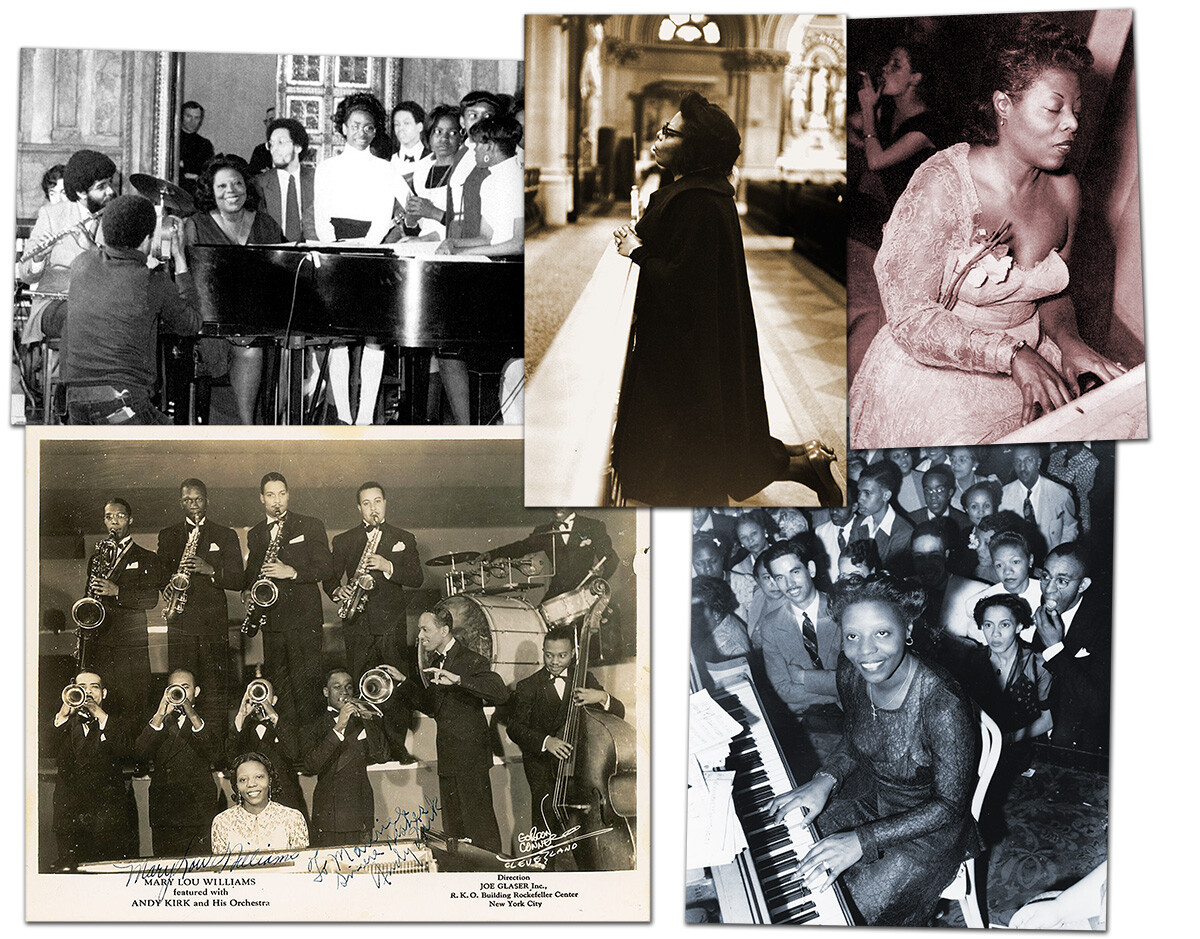Concealed in the shadows of early Jazz, Blues and Popular music history are dynamic and accomplished women who nurtured, guided and developed the music. Several of the most talented and accomplished are profiled below: Lil Hardin who was midwife to the birth of Jazz on record; Ma Rainey, the tough and independent “Mother of the Blues;” and supremely talented trumpet player and singer, Valaida Snow. Composer, arranger, bandleader and radical modernist Mary Lou Williams is featured.

Lil Hardin: Midwife to the Birth of Jazz on Record
Lil (Lillian Hardin) Armstrong (1898-1971) was a brilliant, arranger, composer, bandleader and singer with a flair for promotion. She forged her own path through the male-dominated world of Jazz but has yet to receive full credit for her seminal role.
“Hot Miss Lil,” as she was known around 1920, played piano for bandleader and cornet player Joe Oliver in Chicago. In 1923 she had a key role organizing Oliver’s landmark Creole Jazz Band records. Unlike the men of the band, Hardin had a formal musical education and played a substantial role behind the scenes crafting those Oliver sessions. They were the earliest discs made by a genuine African American Jazz band (with sole exception of Kid Ory’s obscure Sunshine Records made a couple years earlier).
The second wife of Louis Armstrong, Lil tirelessly arranged his early recordings, writing down his ideas, nurturing Louis’ confidence and launching his independent career. She also played a key role in the pivotal Armstrong Hot Five and Hot Seven records of 1925-27 — four dozen historic discs that altered the course of Jazz and introduced its biggest star. Lil supplied the arrangements, rhythmic piano foundation and many of the tunes for those sessions, a handful of which were issued as Lil’s Hot Shots.
Clip A Lil – King Oliver and married to Louis, Got No Blues, Droppin’ Shucks
Clip B Lil – First job, Born to Swing, Knock Kneed Sal
Earning a secondary post-graduate degree in music, Lil Hardin established her own career by the mid-1930s, becoming a successful singer, pianist, songwriter, bandleader and impresario. She even led some of the first all-female jazz bands in Harlem (1931) and Chicago (1934).

In the late-1930s Hardin (aka Hardin-Armstrong) was very productive, recording two dozen discs under her own name at Decca Records. There she also functioned as house pianist (1939-40) accompanying blues singers Rosetta Howard, Peetie Wheatstraw, Blue Lu Barker, Alberta Hunter, trumpeter Henry “Red” Allen and others.
Her hot little bands included such celebrated cats as Buster Bailey (clarinet), Jonah Jones (trumpet), J.C. Higginbotham (trombone), Chu Berry and Prince Robinson (tenor saxes). She hired fine trumpet players, including Jonah Jones and the excellent but little-known Joe Thomas, heard on the majority of her sessions.
Her first Decca session yielded several effervescent titles and a solid-seller entitled “Brown Gal.” The company subsequently promoted her as Lil “Brown Gal” Armstrong on about 25 sides. Lil and Louis were married in 1924 and separated in 1931. But they were not officially divorced until 1938. Despite a lengthy estrangement their professional dealings continued for decades even as his rapid elevation to superstar left her behind.

A dedicated music professional, Hardin was a woman of substance and style. She tried her hand at running a restaurant, attempted a career in tailoring and fashion and lived occasionally in Paris during her later years.
Lil’s death was eerie, coming shortly after Satchmo’s in August 1971. She still owned the Chicago home they bought in the 1920s and in many respects had never ceased considering herself Mrs. Armstrong. Performing at a memorial for Louis she collapsed on stage from a heart attack and could not be revived.
In a 1968 interview Hardin reminisced about her early days with Satchmo, “I could hear Louis coming home whistling for much more than a block away. He had the most beautiful shrill whistle. And all those riffs that he later made in his music he used to whistle . . . such beautiful riffs and runs and trills and things. And I said, ‘Maybe someday that guy will play like that.’ Just crazy thoughts y’know. But it turned out all right; never know when you’re crazy the right way, huh?”
Clip D Lil – Perdido Street Blues, conclusion and East Town Boogie, 1961
Ginger Smock: “Hard-Swinging Intensity”
Formally trained, and a stunning beauty, Jazz violinist Emma “Ginger” Smock (1920-1995) played hot jazz violin in the style of Stuff Smith. Versatile and gifted, she has not received due recognition. Smock appeared on television in Los Angeles where she had her own TV show and performed with the Los Angeles Symphony. During the 1960s and ‘70s she recorded with Rhythm and Blues groups and was the concertmaster at several hotels in Las Vegas backing the likes of Sammy Davis, Jr.

The web page of accomplished jazz violinist Laura Risk sums up her doctoral research into Smock’s “raucous, hard-swinging intensity. Her composition ‘Strange Blues’ . . . evidences a mature musical voice: her solo is rhythmically complex, technically demanding, alternately sassy and delicate, with long melodic lines spun out across the changes.”
Until recently, the only music available of Smock was her 1947 session with the Vivien Garry Quintet. A collection of her recordings was issued for the first time in 2005 by a small British label called AB Fable. Among its contents are “Exactly Like You” from KTLA television, tracks from the 1946 “Girls in Jazz” RCA sessions and “Strange Blues” with the obscure septet of Cecil Count Carter.


Vivien Garry: Bass Professional
The fine string bass player Vivien Garry (c. 1920-2008) had a moderately successful career for about a decade. She worked for small labels, had high-profile exposure on V-Disc during World War Two and then recorded for RCA Victor. Garry worked with vocalist Leo Watson and various independent labels until 1952.
Sophie Tucker: “The Original Red Hot Mama”
Billed as “The Original Red Hot Mama,” Sophie Tucker (Sonya Kalish 1884-1966) was known for suggestive songs and novelties. Big, bold and brassy, her frank and risqué lyrics shocked and titillated Americans and Europeans alike. She toured the European continent, performing in London and for the King and Queen of England respectively in 1926 and 1963.
He Hadn’t Up ‘Till Yesterday, 1928
As early as 1910 her voice was heard on an Edison cylinder recording. Though not a purely jazz singer, Sophie was one of the first to introduce jazz songs and syncopation into her Vaudeville act for white audiences.

Ukrainian-born and Jewish, Tucker was also at the forefront of Yiddish popular music. Her biggest hit was a 1928 bi-lingual recording of “My Yiddishe Momme” with Yiddish lyrics on one side and English on the other.
In her maturity Tucker was rotund and not considered pretty, which she made part of her act in the song, “Nobody Loves a Fat Girl, But Oh How a Fat Girl Can Love.” She did not do well in motion pictures but succeeded grandly on radio — working her way up to hosting a 15-minute program on the CBS network three times a week in the late-1930s.
Sophie’s star rose again in the 1950s and ‘60s when she became popular on television, particularly The Ed Sullivan Show and continued performing until shortly before her passing. She is currently the subject of a combined book, music and documentary film project, The Outrageous Sophie Tucker.
Nobody Loves a Fat Girl, But Oh How a Fat Girl Can Love
Ma Rainey: “Mother of the Blues”
The Classic Blues of Gertrude Pridgett “Ma” Rainey (1886-1939) could be bawdy or sad, bold or profoundly heartbreaking. A tough, independent show business pioneer, her powerful voice and forceful personality forged a path for women’s Classic Blues. Her records sold best in the deep South where rural listeners were familiar with her traveling tent shows.
A commanding presence with an endearing smile full of gold teeth, Rainey was a sight to behold on or off stage. She dressed in gowns covered with beads, bangles and frills, sporting a glittering tiara or headband with a plume of feathers. In performance, she flourished a fan of colored ostrich feathers to stress the beat and emphasized her lines with sweeping gestures. For a hot number she’d lift her skirts and dance with surprising agility.
Clip G – Rainey – Ma Rainey’s Black Bottom, Oh, Papa (1927)
Rainey successfully managed her own business — a caravan of musicians, dancers, entertainers and roustabouts. Her one-time protégé Bessie Smith modeled much of her style on Rainey. But unlike Bessie, she didn’t drink, saved her money and was happily married (in her early years). To her countrified audience, she was a source of pride, even a spokesperson of sorts who often quietly helped needy musicians or other folk down on their luck.
Sticking close to her roots, Ma recorded earthy blues with down-home musicians like popular blues guitarist Tampa Red or the versatile piano player and composer Georgia Tom Dorsey. Her country blues records were rustic with funky guitars, kazoos, jugs and gutty horns. Rainey’s successful recording career during the mid-1920s gradually declined due to hundreds of imitators, changing public tastes and the falling economic status of her mainly African American, largely rural audience.
Rainey sang with her whole body — her rich, deep contralto voice could rise to a roar without amplification. On her best Jazz records, Ma was backed by Chicago bandleader and pianist Lovie Austin, the outstanding New Orleans-born trumpeter Tommy Ladnier and Chicago clarinet player Jimmy O’Bryant.
Unfortunately, most of her discs were made with the early so-called “acoustical” recording system predating the introduction of “electrical” recordings using microphones. But the crude acoustic technology failed to capture the majesty of Rainey’s emotive “moaning” performance style in her prime.
Clip G – Rainey – Lucky Rock Blues, Black Eye Blues, Lord I’m Down with the Blues (1924)
Valaida Snow: “Queen of the Trumpet”

Valaida Snow (1904-1956) had limitless talent. stage charisma, beauty and showbiz savvy. A hot trumpet player in the Louis Armstrong mode, she was billed as “Queen of the Trumpet” or “Little Louis.” An all-around theatrical performer, dancer, singer and multi-instrumentalist, Snow was a Vaudeville trouper before age ten; by age twenty-seven she had performed from the Deep South to Shanghai, China.
Valaida had some noteworthy success in black musical theater, appearing in the road show version of Sissle and Blake’s “Shuffle Along.” In Lew Leslie’s “Rhapsody in Black” on Broadway in 1931 her phenomenal arranging, horn playing, singing, dancing and choreography nearly stole the show from its big star, Ethel Waters.
In Chicago, Snow was briefly mentored by Louis Armstrong and performed at the Grand Terrace Ballroom with pianist and bandleader Earl Hines, who was a paramour. The African American press and gossip columnists found Snow fascinating for her beauty, talent and scandalous lifestyle. But her nearly unlimited gifts went largely unrewarded in America.
You Bring Out the Savage in Me, 1935
Some of These Days, 1937
I Got Rhythm, 1937
High Hat Trumpet and Rhythm, 1937
My Heart Belongs to Daddy, 1939
Moving to Europe in the mid-1930s she made Paris her base of operations and was quickly embraced. The publication Jazz Hot declared in 1936, “We had the pleasure of finding in Valaida the temperament of the great black trumpeters . . . One is obliged to admire the fullness of her tone and the power that no European musician can even approach.”
Traveling the Continent, she lived an expatriate life to the hilt, flaunting an opulent, even decadent lifestyle, cutting records in London, Stockholm and Copenhagen. Her flamboyant affectations included a pet monkey, orchid colored limousine and chauffeur dressed in maroon livery. Valaida’s European touring peaked in Summer 1937 with appearances on the French Rivera and in Holland, Zurich and The Hague.
Snow was among the handful of African American performers who stayed too long in Europe before the Second World War commenced. Detained by wartime authorities, she later falsely claimed that the Nazis had arrested, interned and mistreated her. But she actually spent months in protective Dutch custody pursuant to drug possession charges.
Barely escaping alive, Valaida returned home in June 1942. Quickly regaining her composure, she resumed performing but in increasing obscurity until her little-noted passing in 1956.
Mary Lou Williams: She Did it All
Mary Lou Williams (Mary Elfrieda Scruggs, 1910-1981) was some kind of musical genius. One of the most potent talents of Jazz, she was a gifted bandleader, arranger, composer and piano player. Her music developed in parallel with Jazz itself through Ragtime, Stride and Swing to Boogie, Bop, Modern and beyond.

Performing professionally from the age of fifteen, Mary Lou joined the band of saxophonist John “Bearcat” Williams whom she married in 1926. Their group was the nucleus for what became the popular Andy Kirk orchestra broadcasting out of Kansas City and touring the broad Midwestern dance band territory.
Her skilled direction, dazzling keyboard artistry and distinctive arranging were key factors in the successful dozen-year run of Andy Kirk and the Twelve Clouds of Joy. In the 1930s and ‘40s she wrote arrangements for the stellar Swing orchestras of Benny Goodman, Earl Hines, Tommy Dorsey and Duke Ellington.
Williams’ first piano solo on record in 1930 was a striking and original stride masterpiece. Her Earl Hines-inspired “Night Life” announced the debut of a major jazz talent in 1930. Leonard Feather produced her Girl Stars session of 1946 and sketched “Blues at Mary Lou’s” for a quartet of vibraphonist Margie Hyams, amplified guitar player Mary Osborne and drummer Bridget O’Flynn.
Blues at Mary Lou’s – Girl Stars, 1946

An emerging cadre of Be-Bop revolutionaries like Thelonious Monk, Bud Powell and Charlie Parker gathered at her New York City apartment. Starting in the mid-1940s, Williams progressed decisively into Modern jazz, becoming a bold avant-garde innovator.
Visionary music poured forth as she wrote tunes and arrangements for the orchestras of budding modernists, her own ensembles, and Dizzy Gillespie. “Taurus Mood” is from her inventive “Zodiac Suite,” first performed at Carnegie Hall in 1946 by the New York Philharmonic Orchestra. She wrote and directed “Lonely Moments” for 10-piece orchestra.
Lonely Moments – orchestra, 1947
Converting to Catholicism, Mary Lou retired from music for a few years in the mid-1950s. Resuming composing, arranging and performing, she wrote large-scale sacred works: three masses, a cantata and “Music for Peace” (aka “Mary Lou’s Mass”) choreographed and performed by the Alvin Ailey Dance Theater. Her forward-leaning “Black Christ of the Andes” (Smithsonian Folkways CD 40816) was groundbreaking but controversial.
Anima Christi, 1964
Praise the Lord, 1964

In the 1970s, Williams performed at colleges, taught master classes at Duke University and received numerous honorary degrees. She started her own music publishing company and record label, founded the Pittsburgh Jazz Festival and did some radio and television work. In 1978 Mary Lou performed in Benny Goodman’s 40th anniversary concert at Carnegie Hall and President Jimmy Carter’s White House.
Her final recordings summed up and recapitulated a career progressing through Ragtime, Blues, Stride, Boogie, Swing, Bop and Modern. Few master musicians of any epoch matched Mary Lou Williams breadth of skills, dogged persistence, sheer brilliance or aptitude for innovation.
Clip H – Conclusion_and_Roll-em

Gifts of the Muses
The stories of women who shaped early Jazz, Classic Blues and Popular music reveal that the creative muses granted drive, talent and enterprise to both genders. This is merely an introduction and not a comprehensive survey of the many talented, wonderful women who expressed and supported themselves through music.
Early in the 20th Century, a select vanguard of determined, gifted and charismatic female musicians succeeded artistically and financially despite resistance, skepticism, hostility and ridicule from their male peers and critics. These dynamic women proved themselves equal to men in all aspects of music while looking fabulous and doing it all (as was said of Ginger Rogers dancing with Fred Astaire) “backwards and in high heels.”
Thanks to Mark Miller for consultation regarding Valaida Snow and Hal Smith for assistance.
Read: Dynamic Women of Early Jazz and Classic Blues, Pt 1
Sources and further exploration:
Lil Hardin’s out-of-print 1968 interview by Chris Albertson was issued on Riverside Records. A transcript is found at the Stomp Off website of the late Mr. Albertson.
Black Beauty, White Heat: A Pictorial History of Classic Jazz 1920-50, Frank Driggs and Harris Lewine (Da Capo Press 1995)
High Hat, Trumpet and Rhythm: The Life and Music of Valaida Snow by Mark Miller (The Mercury Press, 2007)
Morning Glory: A Biography of Mary Lou Williams, Linda Dahl (University of California Press, 1999)
Swing Shift: “All Girl” Bands of the 1940s, Sherrie Tucker (Duke University, 2000)
The New Grove Dictionary of Jazz, 2nd edition, Kernfeld, Barry ed. (Macmillan, 2002)
Links:
Five radio programs on Women of Jazz on JAZZ RHTYHM
Lil Hardin Armstrong on JAZZ RHYTHM
Bessie Smith and Ma Rainey on JAZZ RHYTHM
Dave Radlauer is a six-time award-winning radio broadcaster presenting early Jazz since 1982. His vast JAZZ RHYTHM website is a compendium of early jazz history and photos with some 500 hours of exclusive music, broadcasts, interviews and audio rarities.
Radlauer is focused on telling the story of San Francisco Bay Area Revival Jazz. Preserving the memory of local legends, he is compiling, digitizing, interpreting and publishing their personal libraries of music, images, papers and ephemera to be conserved in the Dave Radlauer Jazz Collection at the Stanford University Library archives.

























